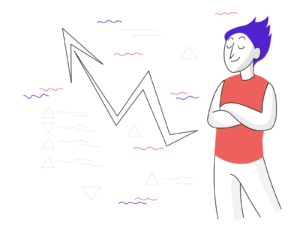When it comes to turning visits into leads, there are many factors to consider. It is important to understand how visitors interact with your website and what tactics you can use to convert them into leads. In this blog post, we will explore the seven most important factors to consider when turning visits into leads.
From website design to content marketing, each factor plays an important role in successfully converting visitors into leads. We will discuss these key elements in detail and provide tips for optimizing each one.
1) Repair broken links
- If you have visitors coming to your website, it’s important to make sure that the links they click on take them to the correct page.
- Broken links are a common source of frustration for visitors, and if left unchecked, they can lead to potential customers leaving your website without taking any action.
- To ensure all links on your website are working correctly, you need to regularly check that they are still active and functioning as intended.
- If you find broken links, you will need to repair them by either redirecting the link to another relevant page or updating it with a new URL.
- It is also important to double-check all outbound links, as these may also be broken if the linked website has changed the URL of the page.
- Additionally, you should add tracking codes to your outbound links so that you can monitor how many people are clicking on them and what pages they are being redirected to.
2) Check if 404 and 301 redirect correctly
- When visitors enter a broken link on your website, it can be frustrating for them and cause them to leave quickly.
- A 404 page not found error occurs when visitors enter an address that no longer exists or never existed in the first place.
- To prevent visitors from getting a 404 page not found error, you should ensure all 404 and 301 redirects are properly set up.
- A 301 redirect is a permanent redirect from one URL to another and tells the web crawlers that the page has been moved. It helps to keep your visitors engaged and on the website, as well as maintaining your search engine rankings.
- A 404 page not found error, however, tells search engines that the page is no longer available, and thus can decrease your website’s rankings.
- To check if your 404 and 301 redirects are correctly set up, use tools such as Screaming Frog or Google Webmaster tools.
- These tools can detect broken links and incorrect redirects, so you can make sure they are set up properly.
- Once you have identified any broken links or incorrect redirects, you can then fix them and make sure your website is running smoothly.
- This will help to improve your website’s usability and help keep visitors on the website for longer.

Awareness
Brand awareness is an inevitable part for any brand to generate demand across their business journey

Visibility
Being more visible to the target audience is the a key factor that accelerate demand.
3) Improve and replace content
- Improving and replacing content is a great way to turning visits into leads. By creating engaging content that offers valuable information, you can help visitors find what they are looking for.
- This not only increases the chances of conversions but also builds trust between your website and potential customers.
- To make sure that your content is relevant, up-to-date, and consistent with your brand, you need to take some steps.
- First, create an editorial calendar and plan out when to post new content and when to update existing content. This will help you stay organized and ensure that you’re consistently creating new content.
- Next, look through your existing content and determine which pieces need to be updated. Outdated or irrelevant content can confuse visitors and result in fewer conversions. Once you know which pieces need updating, create new content that is more engaging and relevant.
- Finally, use SEO best practices while writing content so that it can be found by search engines and direct more traffic to your website.
- By improving and replacing your website’s content, you can give visitors the valuable information they need to make an informed decision and convert into leads.
4) Target your competitor’s consumers
- If you want to turning visits into leads, one of the most important things you should consider is targeting your competitors’ consumers.
- This means researching your competitors’ customers and learning about their needs, wants and behaviors.
- By understanding what drives your competitors’ customers, you can better tailor your product or service to meet their needs and turn them into leads.
- When targeting your competitors’ customers, there are a few key points to consider.
- First, it’s important to find out who your competitors’ customers are and what they need or want from your product or service.
- You can use social media platforms like Facebook or Twitter to gain insights into your competitors’ customer base.
- You can also use analytics tools to analyze the data associated with your competitors’ websites and get an idea of who their customers are and what they’re looking for.
- Once you have a better understanding of your competitors’ customers, you can then create content that speaks directly to them. Develop blog posts, white papers, eBooks, and other resources that specifically address their needs. You can also create ads or campaigns that focus on the benefits of using your product or service over those of your competitors.
- By targeting your competitors’ customers, you can increase the chances of converting them into leads for your business.
- With the right strategy in place, you can quickly turn more visitors into leads and drive more sales for your business.
5) Create customer journey
- Creating a customer journey is essential to ensure that customers can quickly and easily find what they’re looking for.
- It helps provide a roadmap that guides customers through the process of discovering and engaging with your business.
- When crafting a customer journey, you must take into account the customer’s expectations, as well as their needs. You also need to consider the different touch points and channels customers may use.
- Your customer journey should include both physical and digital touch points.
- For example, if you have a store, customers may visit the store, or they may browse your website. Both of these scenarios require different approaches.
- At each touch point, you should consider how the customer interacts with your product or service, and if there are any potential roadblocks or problems that could impede their progress.
- You should also consider how you can use each touch point to provide additional value.
- To create an effective customer journey, you should begin by mapping out the customer’s experience.
- This includes all stages of their journey, from first contact to purchase, and every step in between. During this process, you should be looking for ways to improve the customer’s experience.
6) Arrange personalized demo to your customer
- Arranging personalized demos to customers is a great way to convert visits into leads. Personalized demos provide your customers with the opportunity to get to know your product or service and see how it can benefit them.
- Having an experienced representative shows them how to use the product or service can be invaluable in helping them make their purchase decision.
- When arranging a personalized demo, it’s important to identify the customer’s needs before you even start discussing the product or service.
- This allows you to customize the demo and ensure that you are addressing the customer’s exact needs.
- Additionally, taking time to understand the customer’s budget and timeframe will help you better align the product or service with their expectations.
- During the demo, make sure to focus on the features that best meet their needs and explain any advantages of your product or service.
- Keep in mind that people tend to remember what they hear first and last, so make sure you cover those topics thoroughly.
Catapult Brand Demand with Strategic Content Marketing
Having a content-first approach helps you to create the authority in the sector and generate demand for your brand.
Contact Our Content Manager Now7) Optimize Ad words for long tail keywords
- AdWords is a great tool for converting visitors into leads, but if you want to maximize your efforts, you should consider optimizing AdWords for long tail keywords.
- Long tail keywords are phrases that contain more than three words and are specific to the services or products you offer.
- By using these specific phrases, you can target more qualified leads that are more likely to convert.
- By taking the time to optimize your AdWords campaigns for long tail keywords, you can maximize your conversion rate and get the most out of your AdWords budget.
- Remember, it’s important to continually monitor and adjust your campaigns in order to ensure that you’re targeting the right people with the right message at the right time.
- Once you have identified the best long tail keywords for your AdWords campaigns, you can create ad groups and ads that target these specific keywords.
- You can also add them to existing campaigns, or use them as part of new campaigns. This will help you focus your efforts and budget on those phrases that are most likely to generate conversions.
Conclusion
The process of turning visits into leads is a complex and challenging process, but with the right strategy in place, it can be achieved. By taking into account the seven factors discussed above – repairing broken links, checking 404 and 301 redirects, improving and replacing content, targeting competitors’ customers, creating a customer journey, arranging personalized demos, and optimizing AdWords for long-tail keywords – you can put yourself in the best position to maximize the number of leads your website can generate. With the right approach, you’ll be able to turn those website visitors into loyal customers and increase the success of your business.
Reviewed By
SOJY is a Growth Marketing Strategist with proven expertise in Marketing Psychology, Performance marketing and SEO with over 7 years of experience in the industry. With a passion for helping businesses grow, he has a track record of success in developing and executing innovative marketing strategies that drive growth and ROI.
-
Sojy SNhttps://blog.algorithmc.com/author/sojy/
-
Sojy SNhttps://blog.algorithmc.com/author/sojy/
-
Sojy SNhttps://blog.algorithmc.com/author/sojy/
-
Sojy SNhttps://blog.algorithmc.com/author/sojy/




